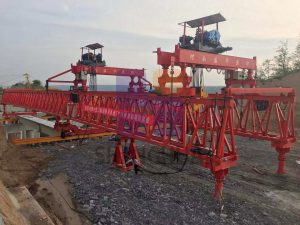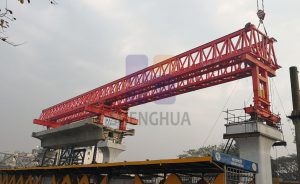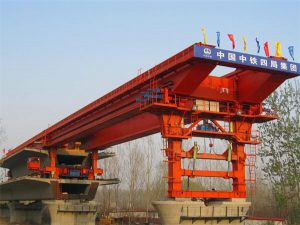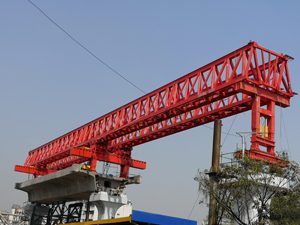Search
Leave Message
Beam Launcher VS Launching Gantry
7. 15th, 2024
In the realm of bridge construction, efficiency, precision and safety are paramount. Among the various techniques employed in the erection of the bridge, the beam launcher and the launching gantry crane stand out as two outstanding methods.
1. Beam Launcher
The beam launcher, also known as a bridge launcher or bridge girder launcher, is a specialized equipment designed for the rapid assembly and installation of bridge girders. The beam launcher typically consists of a launching truss mounted on one or more piers or abutments, along with a self-propelled carrier that moves longitudinally along the bridge axis.
Advantages of the Beam Launcher:
a. Speed: The beam launcher excels in speed and efficiency, allowing for the rapid installation of the bridge girders. The continuous launching process minimizes downtime, resulting in shorter construction schedules.
b. Flexibility: The beam launcher is highly adaptable to a variety of bridge configurations and site conditions. The beam launcher can accommodate different girder types and lengths, making them suitable for a wide range of bridge projects.
c. Minimal Disruption: Since the beam launcher cranes operate primarily from the deck level of the bridge, they cause minimal disruption to traffic flow and surrounding infrastructure during construction.

2. Launching Gantry
The launching gantry, also referred to as a launching truss or overhead launching gantry crane, is another popular method for erecting bridge girders. The launching gantry consists of a preassembled truss structure supported by temporary supports or towers, which traverses along the bridge axis using a combination of hydraulic jacks or self-propelled mechanisms.
Advantages of the Launching Gantry:
a. Heavy Lifting Capacity: The launching gantry crane is capable of lifting heavier bridge segments compared to the beam launcher. This makes them suitable for projects that require the installation of large and heavy girders.
b. High Precision: The launching gantry crane provides precise control over the placement of the girder, ensuring accurate alignment and positioning. This is particularly advantageous in projects with stringent dimensionality requirements.
c. Versatility: The launching gantry can be used for both straight and curved bridge alignment, providing versatility in bridge construction projects with varying geometries.

3. Comparative Analysis of the Beam Launcher and Launching Gantry
a. Cost: The beam launcher is generally more cost-effective for projects involving standard bridge configurations and shorter spans. Launching gantry cranes, on the other hand, entail a higher initial investment, but offer superior lifting capacity and precision, justifying their use in larger and more complex projects.
b. Speed and Efficiency: The beam launcher cranes have an edge in terms of speed and efficiency, thanks to their continuous launching process and minimal setup time. Launching gantry cranes, while slower in operation, provide unparalleled precision and control over girder placement.
c. Project Specificity: The choice between beam launcher and launching gantry often depends on project-specific factors such as bridge span, geometry, site constraints, and budget considerations. Each method has its strengths and limitations, and choosing the most appropriate technique requires a careful evaluation of these factors.
In conclusion, both beam launcher cranes and launching gantry cranes play a crucial role in modern bridge construction, providing distinct advantages depending on the project requirements. While beam launcher cranes excel in speed, flexibility and cost-effectiveness for standard bridge configurations, launching gantry cranes offer superior lifting capacity, precision and versatility for larger and more complex projects. Ultimately, the choice between these two methods for the beam launcher and launching gantry should be guided by a thorough analysis of project parameters to ensure optimal outcomes in terms of efficiency, safety and quality.


